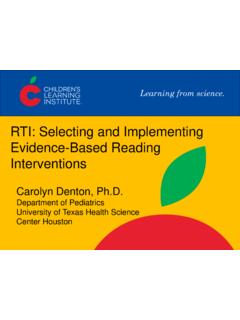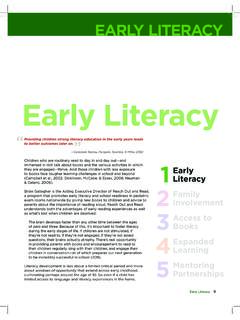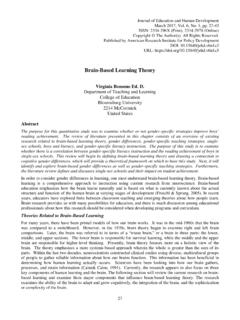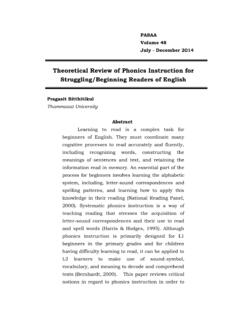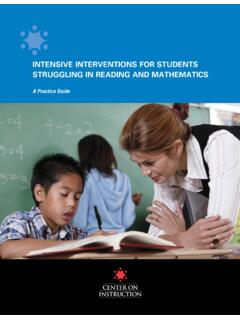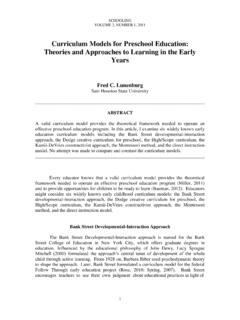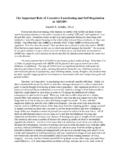Transcription of Fountas and Pinnell Benchmark Assessment System
1 Fountas and Pinnell Benchmark Assessment System Training Webinar Handout 1. Why Fountas and Pinnell Benchmark Assessment System ? It is a reliable, well researched reading Assessment tool. Determines students' instructional and independent reading levels Recommends a placement level for instruction Helps determine initial groups for instruction Identifies students for intervention Monitor and report student progress over time Helps teachers to determine lesson focus 2. Where to get started In September, use last year's June results OR do a Where-to-Start Word test with the student to determine a level (BAS 1 - Edition 3 page 162). Refer to your Benchmark Assessment Forms book for Where-to-start word test, page 162 (Ed 3, System 1). 3 15. Scoring For Edition 1 and 2. Assessment Criteria Grid (BAS). 16. 4. Scoring for Edition 3. Benchmark Resources Assessment System 1. THIRD EDITION.
2 2017, 2011, 2008 by Irene C. Fountas and Gay Su Pinnell . Portsmouth, NH: Heinemann. This page may be photocopied. Scoring and Analysis at-a-Glance Score Part I Oral reading on the Recording Form 1. Accuracy Rate Circle the number of errors to determine the percent of words read correctly. 2. Self-Correction Ratio Calculate the self-correction ratio. (Number of errors + Number of self-corrections) Number of self-corrections = 1: _____. 3. Fluency Score Circle a score. 4. reading Rate Record or calculate the words per minute (WPM) read. (Number of running words [RW] x 60) number of timed seconds read = WPM. Score Part II Comprehension Conversation on the Recording Form 5. Assign points in each category (Within, Beyond, About the Text). 6. Add the category scores and circle the final evaluation in the Guide to Total Score box. Score Part III Writing About reading (optional) on the Recording Form 7.
3 Circle the appropriate score on the scoring key. Complete the Assessment Summary 8. Transfer data from the Recording Form to the Assessment Summary Form. 9. Determine two Benchmark levels and write them in the box in the upper right corner of the Assessment Summary Form.*. 10. Review accuracy, use of sources of information, problem solving, self-correction ratio, fluency, and comprehension to determine the Recommended Placement Level. 11. Use the Guide for Observing and Noting reading Behaviors (in the Assessment Guide, the Assessment Forms book and Online Resources) to make additional comments, and make notes about instructional implications at the bottom of the Assessment Summary Form. *Key for Determining Independent/Instructional/Hard Levels Comprehension Score Comprehension Score Levels Proficient Approaching Limited Proficiency Not Levels Approaching Not Proficiency Proficient Proficient Limited Proficiency A K L Z Proficiency Proficient (5 6) (4) (3) (0 2) (8 9) (6 7) (4 5) (0 3).
4 95-100% Independent Independent Instructional Hard 98-100% Independent Independent Instructional Hard Accuracy Score Accuracy Score 90-94% Instructional Instructional Hard Hard 95-97% Instructional Instructional Hard Hard Below 90% Hard Hard Hard Hard Below 95% Hard Hard Hard Hard 5. Fountas & Pinnell Benchmark Assessment System 1, Third Edition Refer to Langley's Balanced Literacy Framework to determine grade level expectations. 6. Tips for consistency: Before you start know how many errors needed to go from easy to instructional and from instructional to hard. The number on the front right beside the running words (ie. E=21) indicates the number of errors to go from instructional to hard. Introduce the book with the description provided. It is OK for the child to look through the book before reading you are not allowed to discuss the book (be non-comital). If child stops when reading and no problem solving appears to be happening, wait 3 seconds and then give the word (TOLD = 1.)
5 Error). If a child appeals and you think they may know it, say you try it . (Y). If child reads the word correctly, this is not an error. If the child reads the word incorrectly or you have to give a TOLD, it is one error. Self-corrections are not and error. Multiple attempts at a word that end up as incorrect is only scored as one error. Insertions and omissions are counted as an error, even if it makes sense. Proper nouns are only counted as one error, even if repeatedly incorrect. (ie. Ann for Annie, = 1 error even though they incorrectly read this 6 times). If a child misses a page on the BAS, you must ask them to go to the missed page and read (non-BAS running records you would deduct the number of words on that page from the total running words). Once the running record portion is complete the child may read silently, if you feel they will maintain comprehension. After reading , assess comprehension.
6 If you a question is not understood, try rephrasing it. Tell me more or what else do you know are useful prompts to elicit more information. If the child wants to look through the book for the answer, this is OK. You are not to suggest this if they do not initiate it themselves. 7. 8. 9. Insert running record 10. 11. What strategic activity (brain work). do we look for in the early years? One to one matching Directionality Left to right Return sweep Top to bottom Self-monitors (notices errors). Rereading a page, line, phrase or word Cross-checking using another source of information to attempt or make a self-correction Searching for and using more information Self-correcting using letters, parts of words (chunks) or known words to problem solve Predicting what comes next Integrating more than one source of information Is the student an active problem solver or passive? Is the student flexible and tries to problem solve once or multiple times?
7 Our goal is to produce independent readers whose reading & writing improves every time they read and write. 12. 2. Strategic Activities For Higher Readers If we think about what we are looking for and what we are paying attention to when we take running records, perhaps it could help us begin to analyze more carefully changes in the way the child is working on texts.. Julia Douetil Change and Opportunities for Learning 2005, p. 13. 13. 3. Fluency Is Important! What to listen for: Expression and volume Quiet voice or expressive voice Monotone or like talking to a friend Phrasing Word by word, no intonation Word by word with some phrasing and some attention to punctuation Mostly phrased but some choppiness with good intonation. Phrased throughout with good intonation Smoothness Lots of stops, starts, pauses and rereading Some hesitations, some rereading Some smooth parts with some slowing to problem solve Smooth, minor slowing to problem solve and then resumes Pace Slow and laborious Moderately slow Mixture of fast and slow Conversational pace throughout Leach/LRRC 14 8.
8 What should grab your attention in your primary classroom? Word by word reading o Take the finger out, once one to one matching is secure, before working on phrasing ( read with your eyes ). o Make it sound like talking.. o Put these words together.. o Read to your finger.. Sounding out words by single phonemes (w i t h). o Not a helpful strategy, so try: o What would make sense and start like that? . o Think about the story . o You know a word that starts like that/ends like that? o Could it be xxx or . o Use known words to help solve new words. o Model how to chunk words or look for parts that they should know. Not attending to meaning and reading makes no sense o Did that make sense (&/or sound right)? Try that again (encourage rereading to problem solve). o Work on if it does not make sense, reread it! . o reading must make sense, sound right and look right. Not attending to endings o Try that again and look carefully.
9 O Put your finger in and do a slow check of this word.. o Work on chunking words (look/ing). Not attending to the middle of words (ie. Went/want). o Try that again, this word didn't sound right . o Try that again and make it look right and sound right? o Work on noticing medial sounds when appropriate. Choose 1-2 prompts carefully based on your observations and evidence from your running records. Use prompts in your teaching. Adjust as your student makes progress. 15. 9. TOLDS&. Additional&Analysis&Beyond&MSV&. &. What&do&TOLDs&reveal&that&can&drive&our& teaching?&. &. Types&of&TOLDs:&. &. 1.! TOLDs&after&no&action&&&&&. &B&. & & & &&&&&&&&&&&said&&&&&T&. &. o! How&might&I&shift&my&prompting&tomorrow& so&that&my&student&might&begin&to&make&a n&. attempt&at&an&unknown&word?&. o! What&prompts&might&I&try?&. &. 2.! TOLDs&after&limited&action:&. wB&&&&&&&&&&&&&&&&&&&&&&&&&&&&&&&&&&&hap py&&&&&&&&&&&&&&&&&&&&&&&&&&&B&&&&&&&&&& &&R&.
10 Was&&&&&&&T&&&&&&&&&&&&&&&&&&&&&&&him&&& &&&&&&&T&&&&&&&&&&&&&through&&&&&&&&&&&& &T&. &. trBeBs&&&&&&&&&&&&&&&&&&&&&&&&&&&&&&&&&B &&&&&&&&A&&&&&&&&aB&&&. treasure&&&&T&&&&&&&&&&&&&&&&&&&and&&&&& &&&&&&Y&&&&&&&&T&. &. o! Child&used&just&part(s)&of&a&word,&a&sub stituted&word,&or&rereads&and&stops&furt her& There&is&a&pause&where&you&&give&a& o! What&source(s)&are&being&used,&what&are& being&neglected?&. o! What&do&I&need&to&teach&for&so&my&studen t&can&be&successful&next&time?&How&can&I &prompt&so&. they&will&make&more&effort&the&next&time ?&. &. &. 3.! TOLDs&after&multiple&actions&. in&&&&&&&&&R&&&&&thB&. &&&&&&&&&&&&&&&&&&&&&&&&&&&&&&&&&&&. &&&&&&&&&&through&&&&&&&&&&&&&&&&T&. &. o! Child&makes&more&than&one&attempt,&analy ze&each&attempt&. o! What&source(s)&are&being&used,&what&are& being&neglected?&. o! What&do&I&need&to&teach&for&so&my&studen t&can&be&successful&next&time?&. o! What&prompts&can&I&use&to&support&my&stu dent&to&be&more&independent?


